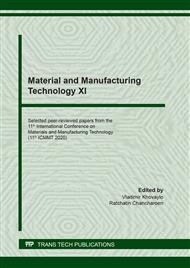p.114
p.123
p.131
p.141
p.147
p.153
p.160
p.166
p.172
Characterization and Identification of Fatty Acid Ethyl Esters from Refined Used Cooking Oil as Biodiesel by Using Spectroscopic Techniques Approach
Abstract:
Fatty acids composition in used cooking oil vary that need to analyze before making biodiesel to meet the requirement of a diesel engine. The purpose of this study was to identify and characterize fatty acid ethyl ethers in used cooking oil refined using various acids after a one-stage transesterification process using a heterogeneous CaO catalyst to produce biodiesel. The analytical method applied was spectroscopic technique by using Fourier Transform Infra Red (FTIR) and Gas Chromatography-Mass Spectrometry (GC-MS) instruments. The results showed that the characteristics of fatty acid ethyl esters from used cooking oil that refined using phosphoric acid were superior to than sulfuric acid and hydrochloric acid. Six peaks with m/z 88 fragments as markers of fatty acid ethyl esters and two peaks identified as ethyl linoleate and ethyl oleate as unsaturated fatty acids characterize by GC-MS. FTIR showed an increase of intensity at wavenumber of 2500-1500 cm-1 which was a weak bond. A similar functional group identified by FTIR in biodiesel from refining used cooking oil obtained lower intensity than commercial diesel fuel.
Info:
Periodical:
Pages:
172-179
Citation:
Online since:
February 2021
Authors:
Keywords:
Price:
Сopyright:
© 2021 Trans Tech Publications Ltd. All Rights Reserved
Share:
Citation:


